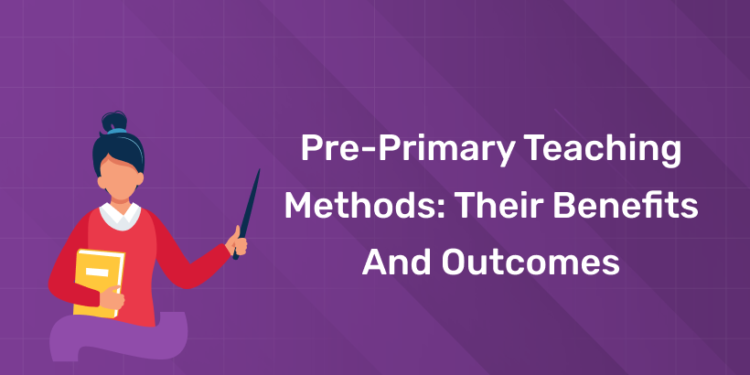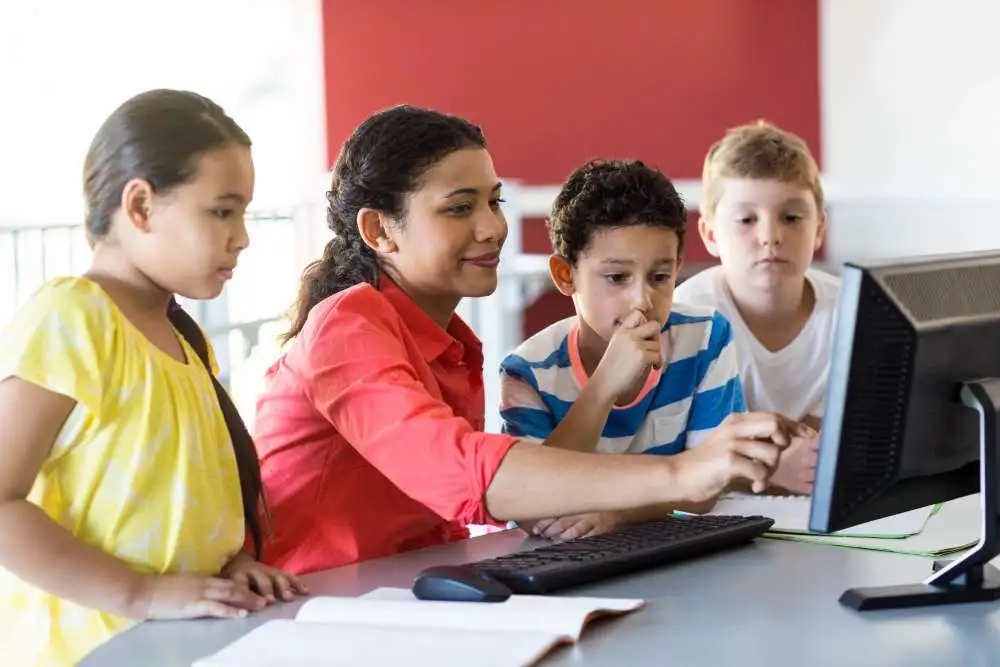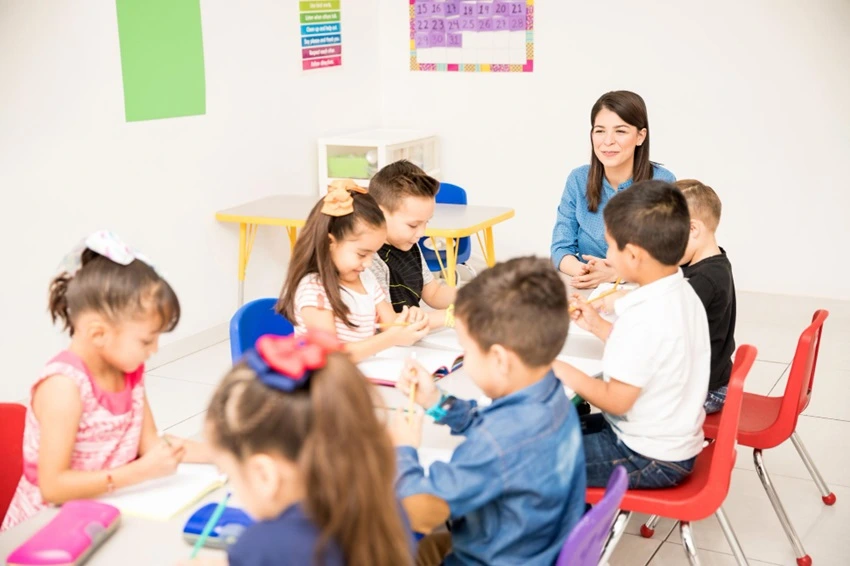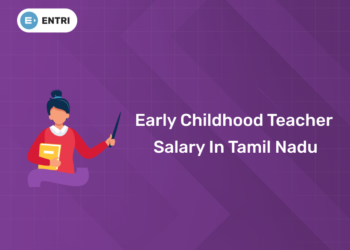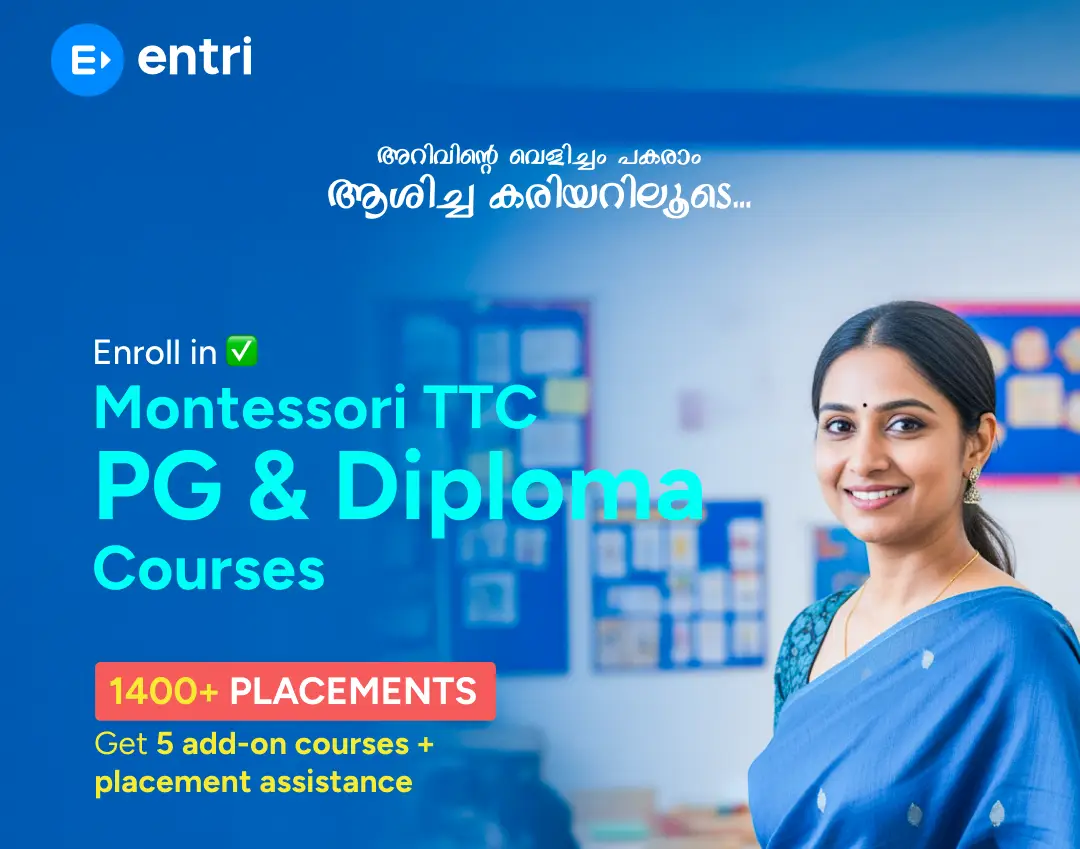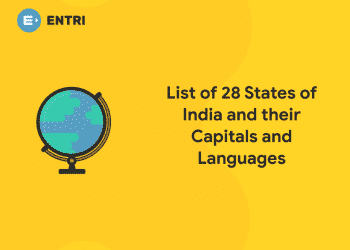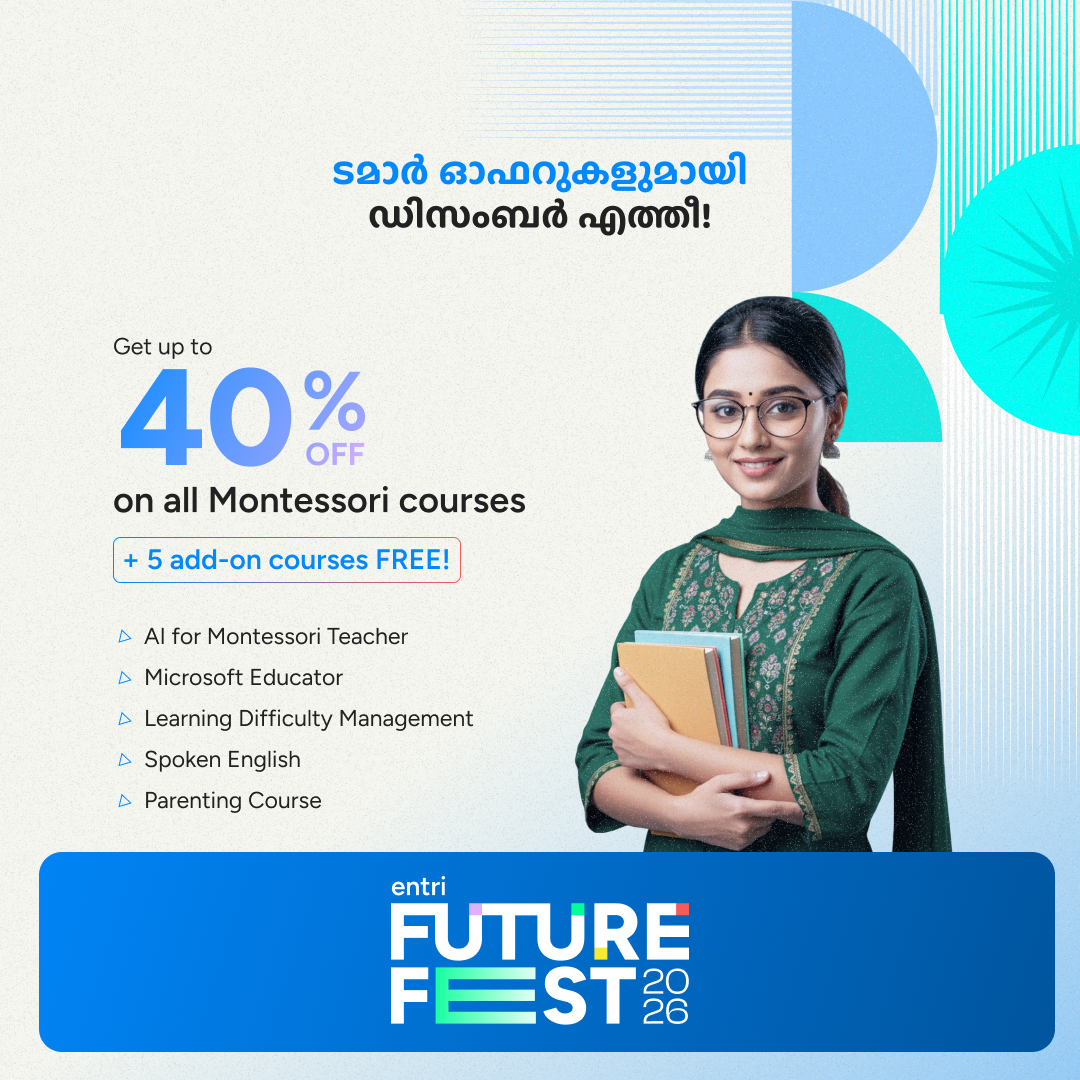Table of Contents
Pre‑primary years (roughly ages 3–6) are magical. In those formative years, children absorb language, social skills, early numeracy, and emotional awareness. The methods we adopt in this crucial stage can profoundly influence a child’s trajectory. For teachers and aspiring educators, mastering effective pre‑primary teaching methods is not just a pedagogical ideal; it’s a professional differentiator.
In this blog post, we will:
- Examine major pre‑primary teaching methods
- Explore their benefits and real outcomes (for children, teachers, institutions)
- Understand how these methods relate to modern demands in education
- Show how upskilling via courses like Entri Montessori TTC aligns with implementing these methods
- Share key takeaways you can apply right away
Register for the Entri Elevate Montessori Teacher Training Program! Click here to join!
Why Teaching Methods at Pre‑Primary Matter (More Than You Think)
Before we dig into particular strategies, it is helpful to understand why method counts so much in early childhood classrooms.
- Base of lifelong learning: Early experiences establish neural patterns and instincts for curiosity, self-regulation, and social interaction. Top-notch early teaching produces superior long-term results.
- Closing gaps early: Quality pre‑primary approaches curb differences between kids from various backgrounds.
- Maximizing developmental windows: Toddlers learn best through play, exploration, sensory experiences and scaffolding. Traditional lecture methods do not take advantage of this.
- Teacher influence is huge: Research indicates that preschool teachers’ teaching styles are highly associated with students’ social, emotional, and cognitive development.
- Longer-term benefits: robust early education contributes to reduced repetition, drop out, and later academic achievement.
Therefore, the selection and implementation of pedagogical practices is not a choice; it’s fundamental to if your pre‑primary environment turns out to be impactful or merely “adorable.”
What Are Pre-primary Teaching Methods?
1: What is the primary focus of the first plane of development in the Montessori method?
Pre-primary teaching practices are the strategies educators employ to encourage social, emotional, physical, and cognitive growth in 3–6-year-olds. Though older approaches prized rote learning, today’s classrooms mix together play-based, experiential and child-centric methodologies. Popular approaches include:
1. Montessori Method
Essence: Focuses on independence, hands-on exploration, and respect for each child’s pace.
Benefits:
- Students build confidence and responsibility by selecting activities on their own.
- This hands-on material develops fine motor skills, number sense, and general problem-solving.
- Diverse classrooms encourage empathy, social skills and a lifelong thirst for learning.
- Outcomes:
Kids become self-motivated learners, emotionally resilient, and make an easy transition to elementary school. Montessori-trained teachers (such as those certified through the Entri Montessori TTC course) tell us of calmer, more engaged classrooms where each child’s development is treasured.
2. Play-Based Learning
Essence: Uses play for academic, social, and emotional growth.
Benefits:
- Both storytelling and games enhance vocabulary, communication, and creativity.
- Play fosters collaboration, creativity, and self-control.
- Outcomes:
Studies indicate that play-centric learning generates superior problem-solving, memory, and adaptability. Kids are braver, more inquisitive, and have deeper friendships.
3. Reggio Emilia Approach
Essence: Recognizes children as capable, imaginative, and collaborative learners. Teachers and parents co-produce the learning path.
Benefits:
- Initiatives and investigations foster analytical and leadership abilities.
- Art, music, and movement are interwoven daily, developing expressive skills.
- Outcomes:
Children become inquisitive explorers, skilled at communication and teamwork. Classrooms evolve as creative communities.
4. Thematic and Integrated Learning
Essence: Combines multiple subjects into real-world themes.
Benefits:
- Themes (eg. ‘My Family’, ‘Seasons’) assist you in making connections across language, math, science and art.
- Encourages holistic understanding and relevance.
- Outcomes:
Students develop better comprehension, interdisciplinary skills, and retention. Teachers can more easily customize lessons and accommodate different learning styles.
5. Technology-Enabled and Gamified Learning
Essence: Incorporates digital tools, smart boards, and educational apps into daily lessons.
Benefits:
- These personalized learning paths adjust to every child’s strengths and challenges.
- Gamified apps cultivate drive and affective involvement.
- Outcomes:
Children show improved digital literacy, problem-solving, and self-confidence. What a balance of technology breaks student learning barriers in urban and rural India.
Get Certified & Start Your Montessori Career
Montessori Teacher Training Course by Entri App: Gain expert skills, earn certification, and kickstart your teaching career.
Join Now!Benefits & Outcomes: What Research Finds
These methods work. Here are the benefits (for learners and educators) backed by research with examples.
For Children
- Cognitive & academic growth
- Better language, vocabulary, early literacy, and numeracy skills.
- Stronger executive functions: self-control, working memory, flexible thinking.
- Scientific thinking, curiosity, and inquiry tendencies develop when children experiment, ask questions, and test ideas.
- Fewer retention and drop-out risks in primary grades.
- Social & emotional development
- Improved collaboration, emotional regulation, and conflict resolution.
- Enhanced empathy, self-esteem, and ability to express and understand feelings.
- Better adaptation to group settings, sharing, turn-taking, and peer relationships.
- Motivation, confidence & love for learning
- Children who direct parts of their learning feel agency and ownership.
- Play and explorative approaches make learning fun, not a chore.
- Better attention and engagement in class.
- Creativity, problem-solving & critical thinking
- Open-ended play and project work promote lateral thinking, experimentation.
- Opportunity to fail safely, iterate, reflect, and improve.
- Children develop “learning how to learn” mindsets.
- Physical development & sensory integration
- Fine motor skills (cutting, threading, writing) and gross motor (running, climbing) improve.
- Sensory play (sand, water, clay) helps neural integration and perceptual refinement.
- Equity & bridging gaps
- Under-resourced children gain vocabulary, general knowledge, and readiness.
- Early intervention via strong methods narrows achievement gaps early.
Benefits & Outcomes for Teachers and Institutions
- Stronger teacher-child relationships
- Observational, child-led methods help you get to know each child.
- You become a trusted guide, not just an instructor.
- Reflective and responsive teaching
- You develop skills in observation, planning, and adjusting on the go.
- Feedback loops allow continuous improvement of practice.
- Professional credibility & growth
- Mastery of advanced early methods is a mark of quality.
- Opens up roles in curriculum design, teacher mentoring, and leadership.
- Higher retention and reputation
- Schools known for good early pedagogy attract parents; show better outcomes.
- Less teacher burnout when methods match developmental needs (less frustration).5. Primary transition
- Children from well-run pre-primary classes transition better into primary with less remediation.
- Better longitudinal data.
- Resource utilisation
- Well-planned environments and routines mean classes run more smoothly; time is used more effectively.
- Fewer disruptions and behaviour issues when children are engaged.
Challenges & Pitfalls: What to Watch Out For
- Over-structuring vs under-structuring: Too rigid planning kills child initiative; too loose planning may miss foundational skills.
- Insufficient teacher training: Teachers must learn to observe, scaffold, guide subtly, not just supervise play.
- Poor environment or materials: If the classroom lacks rich, safe materials, methods fail.
- Large class sizes: Harder to individualize or scaffold.
- Assessment and documentation balance: Overemphasis on tests kills the spirit of inquiry; under-documentation reduces accountability.
- Parental expectations/pressure: Some parents expect formal academic “teaching” too early.
- Inconsistent implementation: Applying methods superficially (e.g. “a little play” in between lectures) dilutes benefits.
How to Integrate These Methods in Everyday Pre‑Primary Classrooms
Here are practical steps and strategies:
- Design a “prepared environment”
- Zones: language corner, block area, art, sensory table, and outdoor.
- Rotate materials; keep them accessible, labeled, and safe.
- Use open-ended materials (blocks, clay, loose parts) alongside structured ones.
- Daily balance of child choice + guided experiences
- Begin the day with free play/exploration time.
- Mid-morning, conduct a small-group guided activity (phonics, number games).
- Use transitions (snacks, circle time) to introduce songs, stories, and movement.
- Observational planning & scaffolding
- Observe children’s interests, challenges, and strengths.
- Scaffold: ask open-ended “What if …?” questions, suggest next steps, model tasks, fade support.
- Document observations for later planning.
- Use project-based / thematic work
- For example: “Seasons” project: children explore leaves, weather, dress, stories, art, and walk outdoors.
- Connect language, maths, and science in that project.
- Revisit the project for several weeks, and deepen it gradually.
- Incorporate multisensory & experiential tasks
- Sand/water tables, tactile letters, clay, sensory bins.
- Movement games, songs, acting out stories.
- Outdoor explorations, natural objects, nature walks.
- Reflection, feedback, and adaptation
- At the end of each session, reflect: what worked, what didn’t, and next steps.
- Engage children: ask them what they liked, what surprised them.
- Adjust upcoming sessions accordingly.
- Documentation & sharing
- Use portfolios, learning journals, and photo documentation of child work.
- Share with parents: show progress, invite co-involvement.
- Use display walls or child presentations (show and tell).
- Continuous professional development
- Attend workshops, observe model preschools, and join teacher communities.
- Try small experiments and reflect (e.g. change one corner, new material, method tweak).
Get Certified & Start Your Montessori Career
Montessori Teacher Training Course by Entri App: Gain expert skills, earn certification, and kickstart your teaching career.
Join Now!Role of Montessori in Applying These Methods
If you’re serious about mastering early education methods, the Montessori approach is a powerful complement (or even foundation). Here’s how:
- Montessori emphasizes a prepared environment, self-directed work, and materials geared for sensory, control of error, and sequencing.
- It aligns naturally with play-based, child-initiated, multisensory learning.
- Montessori-trained teachers refine observation, subtle guidance, and trust in the child’s pace.
One accessible path in India is the Entri Montessori TTC course. Here’s how it aligns with implementing strong pre-primary methods:
| Feature / Component | How It Helps You Implement Pre‑Primary Methods |
| Training in Montessori philosophy & pedagogy | Deepens your understanding of child‑led learning, prepared environment, and freedom within limits |
| Practical sessions & internship | You get hands-on experience with materials and observing children |
| Flexible delivery modes | You can learn while working; adapt at your own pace |
| Recognition & certification | Enhances your professional credibility |
| Placement support | Helps you start applying these methods in real schools |
By upskilling with Entri Montessori TTC alongside your own practice of play-based, scaffolding, multisensory, and thematic methods, you can become a more confident, skilled, and differentiated educator.
Sample Week Plan Illustrating Integrated Methods
| Day | Morning Routine | Play / Exploration | Guided / Small Group | Project / Theme Work | Reflection / Wrap-up |
| Monday | Circle time + song | Free play in stations (blocks, art, sensory) | Phonics small groups (sound games) | Theme intro: “Plants” (explore seeds, leaves) | Story & ask “What did we try tomorrow?” |
| Tuesday | Movement + rhyme | Child‑choice play | Numeracy groups (counting, pattern) | Planting seeds, observing soil | Share observations, documentation |
| Wednesday | Story & questions | Play with seeds, water, and soil | Language groups (vocabulary) | Nature walk, leaf collection | Child-talk: what surprised you? |
| Thursday | Song + calendar | Sensory and manipulative play | Math games | Leaf art, counting, sorting | Gallery walk of children’s work |
| Friday | Recap & share | Free play revisited | Mixed ability groups | Culminating mini project/presentation | Parents share or display |
This plan blends child-initiated play, scaffolding, teacher-led instruction, multisensory work, and documentation a healthy mix of approaches.
Key Takeaways
- One method is rarely enough: the best pre‑primary classrooms blend play, child‑led, guided instruction, scaffolding, multisensory learning, and thematic or project integration.
- Implementing the method well matters more than choosing a fancy label: even simple play corners or scaffolding techniques done thoughtfully create a big impact.
- Outcomes are broad and deep: cognitive growth, social-emotional skills, lifelong curiosity, equity gains, and smoother primary transitions.
- Teacher growth is critical: observation, reflection, adaptation, and ongoing learning make the difference.
- Montessori is highly complementary: a strong foundation in Montessori can deepen child‑led and environment‑based practice.
- Upskilling via structured courses helps: courses like Entri Montessori TTC give you the skills, confidence, recognition, and practical exposure to translate theory into effective classroom practice.
Final Thoughts
Pre‑primary teaching is an art and science. The methods you choose, the environment you craft, the ways you scaffold and listen, these decide whether a classroom is just “cute playtime” or a launchpad for lifelong learning.
If you’re a teacher or aspiring educator, start with one corner or one hour per day, try a play-based station, observe children quietly, and scaffold one task. Over time, layer more methods, document, reflect, and grow.
Pair your practice with a strong, recognized training path such as Entri Montessori TTC, so you get both philosophical depth and practical mastery. Over months, you will see improved child outcomes, greater professional confidence, and a more meaningful teaching journey.
| Also Read | |
| 5 Ways Montessori Teacher Training Benefits Children | |
| What Qualifications Do You Need for Kindergarten Teacher Jobs? |
|
| Montessori Pink Tower Making | |
| Knobbed Cylinders in Montessori | |
Get Certified & Start Your Montessori Career
Montessori Teacher Training Course by Entri App: Gain expert skills, earn certification, and kickstart your teaching career.
Join Now!Frequently Asked Questions
What are the main pre-primary teaching methods used in India?
Popular methods include Montessori, play-based learning, Reggio Emilia, thematic approaches, and technology-driven teaching. Each focuses on holistic development and child-centered education.
How does Montessori teacher training benefit pre-primary educators?
It equips teachers with hands-on, scientific techniques, improves classroom management, and boosts employability across Indian and Gulf schools.
What outcomes can parents expect from modern pre-primary teaching?
Children develop better social skills, emotional resilience, cognitive ability, language proficiency, and creativity through up-to-date teaching methods.
Is play-based learning more effective than traditional teaching?
Yes, play-based techniques promote better retention, engagement, problem-solving, and adaptability compared to rote memorization.
How does technology help in pre-primary classrooms?
Technology offers personalized learning, interactive activities, and supports differentiated instruction for diverse learner needs.
Who should enroll in Entri’s Montessori Teacher Training Course?
Aspiring teachers, current educators, and school staff looking for recognized upskilling and modern classroom expertise in India and the Gulf.


